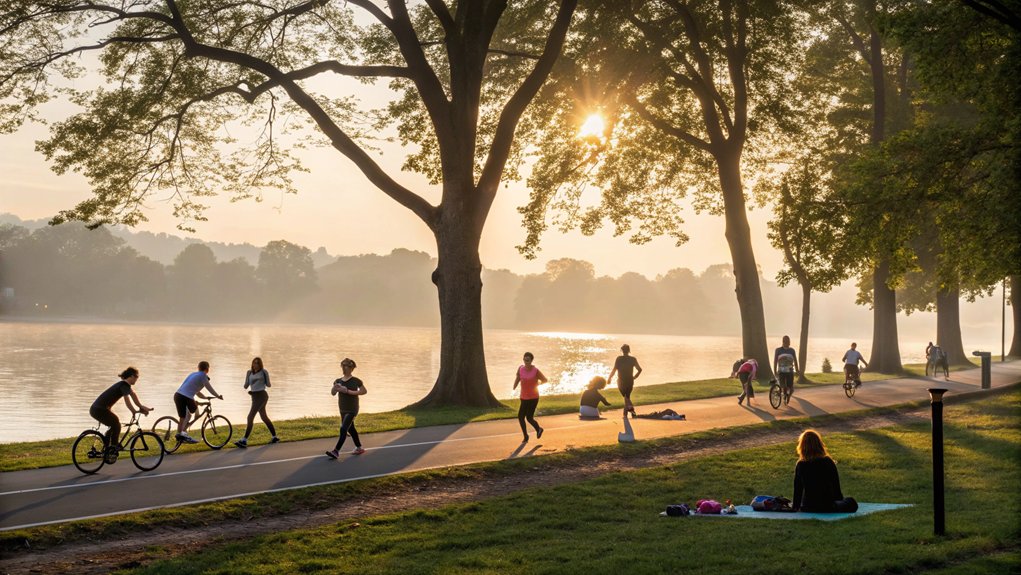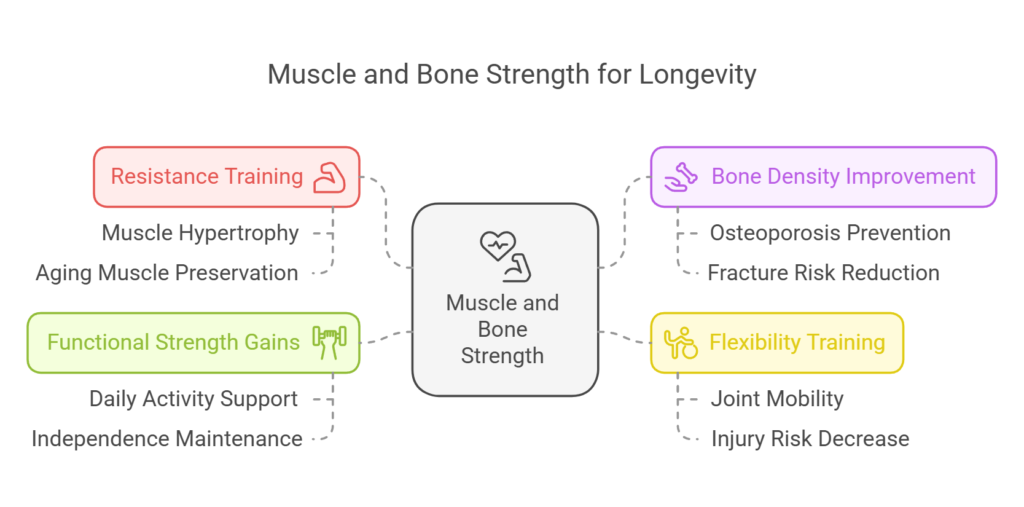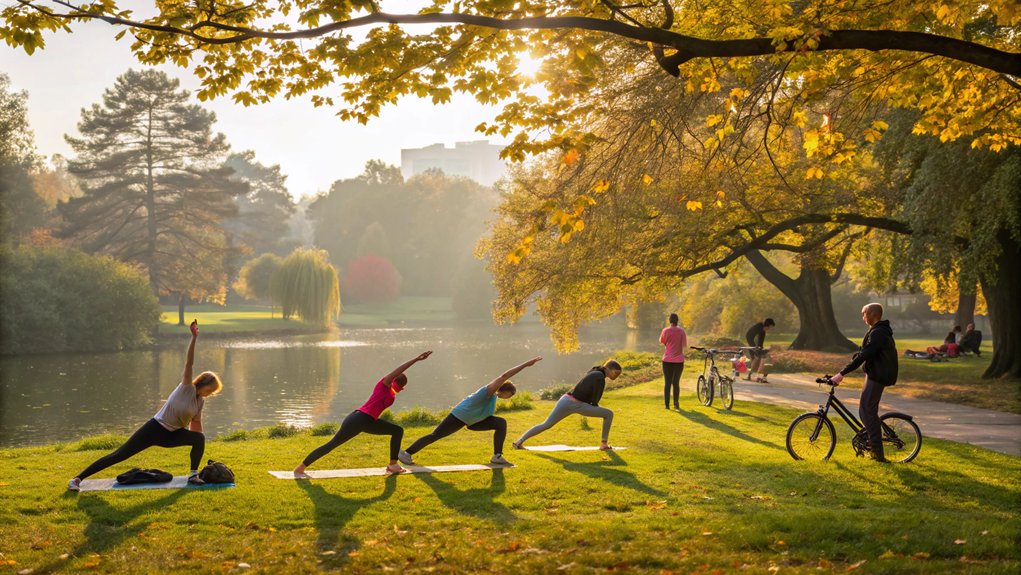How Does Exercise Increase Healthspan and Enhance Well-Being?

Prefer listening? Check out the podcast version of this article.
Coincidentally, as you contemplate longevity, exercise emerges as a key factor in extending healthspan.
It’s fascinating how regular physical activity rewires your body’s systems, promoting cardiovascular health, muscle strength, and cognitive resilience.

The evidence is clear: exercise stimulates brain-derived neurotrophic factor (BDNF), enhancing mental clarity and emotional stability.
Yet, the full scope of exercise’s biological benefits remains an intriguing puzzle, waiting to be explored further.
Table of Contents
Physical Activity as Nature’s Longevity Booster
When you engage in regular physical activity, you optimize your heart and blood system, fostering improved circulation and reduced cardiovascular risks.
Exercise also strengthens your muscles and bones, combating age-related decline and promoting structural integrity.

Furthermore, consistent physical activity aids in weight management and disease prevention, significantly lowering the risks of chronic conditions like diabetes and heart disease.
Heart and Blood System Optimization
Exercise acts as nature’s longevity booster by optimizing the heart and blood system, a pivotal component of healthspan extension.
Engaging in regular physical activity enhances cardiac efficiency, promoting robust heart rate management and improved blood flow.
Research shows that increased exercise intensity bolsters vascular resilience, effectively reducing cholesterol levels and the risk of heart disease.
| Benefit | Mechanism | Outcome |
|---|---|---|
| Cardiac Efficiency | Enhanced heart rate control | Improved blood circulation |
| Vascular Resilience | Strengthened blood vessels | Lower disease risk |
| Cholesterol Levels | Reduced LDL, increased HDL | Decreased heart disease |
Muscle and Bone Strength Development
While many focus on cardiovascular benefits, the impact of physical activity on muscle and bone strength is equally significant in boosting longevity.
Engaging in resistance training is crucial for muscle hypertrophy benefits, helping you maintain muscle mass and combat age-related muscle loss.
Discover Your Path to a Longer, Healthier Life!
Take our free quiz to see how your lifestyle measures up to the world's longest-living communities and receive expert tips for a healthier, longer life.
Take the QuizThis kind of exercise is vital for aging muscle preservation, ensuring you stay strong and independent as you age.
Regular physical activity also leads to bone density improvement, reducing the risk of fractures and osteoporosis.
Flexibility training effects enhance joint mobility and decrease injury risk, while functional strength gains support everyday activities.
Emphasizing these aspects of physical fitness ensures you’re not only living longer but also maintaining a high quality of life as you age.

Weight Management and Disease Prevention
Regular physical activity plays a pivotal role in weight management and disease prevention, serving as nature’s most effective longevity booster.
By integrating exercise into your lifestyle habits, you can employ weight management strategies that complement your nutritional choices.
Exercise enhances metabolic health improvement, helping regulate body weight and thwart the onset of chronic diseases like type 2 diabetes and cardiovascular conditions.
Disease prevention tactics include consistent activity, which bolsters your immune system and reduces inflammation.
However, exercise adherence challenges can arise, necessitating tailored approaches to sustain motivation and consistency.
Exercise Rewires Body’s Health Systems
When you engage in regular exercise, it triggers beneficial changes in the brain that enhance cognitive function and boost mental acuity.
Physical activity also acts as a natural mood stabilizer, reducing symptoms of anxiety and depression while promoting better sleep quality.
Additionally, consistent exercise elevates your energy levels by improving cardiovascular efficiency and metabolic function, providing sustained vitality throughout the day.
Brain Power Enhancement
Engaging in regular exercise doesn’t just strengthen your body; it also rewires and enhances your brain’s capabilities.
Exercise is a potent catalyst for brain health, improving cognitive function through the benefits of neuroplasticity.
By promoting neural growth and connectivity, physical activity aids memory improvement and boosts mental resilience.
Scientific studies show that exercise stimulates the production of brain-derived neurotrophic factor (BDNF), a protein critical for neuroplasticity, which enhances the brain’s adaptability to new challenges.
Furthermore, regular physical activity is effective in stress reduction, lowering cortisol levels and promoting a sense of calm.
This stress relief supports robust cognitive function, ensuring your brain remains agile and sharp as you age.
Thus, incorporating exercise into your routine is essential for maintaining optimal brain power.
Mood and Sleep Improvement
Although exercise is often celebrated for its physical benefits, its impact on mood and sleep is equally profound, rewiring the body’s health systems in remarkable ways.
Engaging in regular physical activity is shown to elevate mood by boosting the production of endorphins, which are natural mood elevators.
This biochemical change also contributes to stress reduction and anxiety relief, fostering a sense of emotional balance.
Additionally, exercise enhances sleep quality by regulating circadian rhythms, leading to more restorative rest.
Improved sleep further supports mental clarity and cognitive function, creating a positive feedback loop that enhances overall well-being.

Scientific evidence consistently supports these benefits, illustrating how exercise not only strengthens the body but also profoundly enriches mental and emotional health.
Energy Level Elevation
Exercise significantly elevates energy levels by fundamentally rewiring the body’s health systems.
Engaging in regular physical activity enhances mitochondrial function and oxygen utilization, crucial energy boosting techniques.
To maintain motivation, employ exercise motivation strategies like setting achievable goals and using fitness tracking tools.
These tools provide data-driven insights, helping you monitor progress and optimize routines.
Participating in group workouts offers social support and accountability, further increasing energy levels.
The advantages of outdoor activities include exposure to natural light, which boosts mood and energy.
However, remember that recovery and rest are essential components of any fitness regimen.
Adequate rest prevents fatigue and encourages the body’s adaptation to exercise, ensuring sustained energy elevation and overall well-being improvement.
Lifespan Extension Through Movement
Engaging in regular physical activity is associated with a significant reduction in mortality risk, suggesting that movement plays a crucial role in extending lifespan.
Evidence indicates that elite athletes, particularly those in endurance sports, tend to live longer, with life expectancy increases of several years compared to the general population.

To achieve these benefits, meeting or exceeding the recommended daily activity requirements is essential, as greater levels of exercise correlate with a lower risk of premature death.
Mortality Risk Reduction
When you incorporate regular physical activity into your routine, you significantly reduce your mortality risk, effectively extending your lifespan.
Mortality statistics reveal a clear correlation between exercise frequency and reduced mortality risk, highlighting the healthspan benefits of consistent physical activity.
Age-related factors and lifestyle choices play critical roles in determining your overall health outcomes.
Engaging in regular exercise helps mitigate these factors, offering a proactive approach to longevity.
| Exercise Frequency | Mortality Risk Reduction |
|---|---|
| Low | Minimal |
| Moderate | Moderate |
| High | Significant |
Physical activity not only extends lifespan but also enhances the quality of life, reducing the risk of chronic diseases.
By prioritizing movement and making informed lifestyle choices, you actively contribute to a longer, healthier life.
Elite Athletes Living Longer
Building on the understanding that regular physical activity reduces mortality risk, exploring the specific impact on elite athletes reveals even more impressive lifespan extensions.
Elite athlete training, characterized by rigorous endurance exercise impact and strategic athlete lifestyle choices, is linked with enhanced longevity.
Longevity research studies show that competitive sports benefits extend life expectancy by several years compared to non-athletes.
Here’s what you should know:
- Longevity Boost: Elite athletes can live 4.3 to 8.0 years longer than the general population.
- Healthier Aging: Fitness and aging studies indicate improved cardiovascular and metabolic health.
- Mental Resilience: Consistent training fosters better mental health and cognitive function.
- Disease Prevention: A significant reduction in chronic disease incidence is linked with competitive sports involvement.
These findings emphasize the profound benefits of elite athleticism on lifespan.
Daily Activity Requirements
To maximize healthspan and lifespan, adhering to daily activity requirements is crucial.
Daily activity tracking helps maintain an active lifestyle, reducing sedentary lifestyle risks.
Following exercise frequency guidelines ensures you’re meeting physical fitness goals.
Prioritize movement variety importance to engage different muscle groups, enhancing overall health benefits.
The active lifestyle benefits are immense, supporting cardiovascular health, muscle strength, and mental well-being.
| Sedentary Lifestyle Risks | Active Lifestyle Benefits |
|---|---|
| Increased disease risk | Enhanced cardiovascular health |
| Muscle atrophy | Improved muscle strength |
| Poor mental health | Boosted mental well-being |
Adopt a proactive approach to your health by integrating varied activities into your routine, such as aerobic exercises, strength training, and flexibility exercises.
These habits not only extend your lifespan but also improve your quality of life.
Biological Transformation with Exercise
When you engage in regular exercise, you’re not just improving surface-level fitness; you’re facilitating profound biological transformation.
Exercise enhances the power of your cellular “power plants,” the mitochondria, boosting energy production and efficiency.
Lifespan Comparison Tool
Compare the life expectancy by the U.S. State
This activity also promotes beneficial adaptations across multiple organ systems, supporting long-term health maintenance and reducing all-cause mortality.
Cell Power Plant Enhancement
While exercise transforms your body externally, its most profound impact occurs at the cellular level, particularly in enhancing the function of the cell’s power plants—mitochondria.
Regular physical activity optimizes energy production and efficiency by stimulating the mitochondrial biogenesis process.
This results in improved cell metabolism efficiency, which supports better overall health.
Exercise-induced adaptations bolster cellular repair mechanisms and reduce oxidative stress, protecting cells from damage and extending their lifespan.
To illustrate:
- Increased Mitochondrial Density: More mitochondria mean better energy production.
- Enhanced Oxidative Stress Resistance: Exercise helps cells combat harmful free radicals.
- Improved Cellular Repair: Regular activity facilitates quicker recovery and maintenance.
- Optimized Energy Utilization: Efficient energy use supports sustained physical activity.
These cellular enhancements contribute significantly to increased healthspan.
Multiple Organ System Adaptation
Exercise induces significant biological transformations by promoting adaptations across multiple organ systems.
When you engage in regular physical activity, you stimulate exercise benefits that enhance cellular adaptation and foster health synergy.
Each organ system, from musculoskeletal to endocrine, responds uniquely to exercise, contributing to holistic wellness and physical resilience.
For instance, your cardiovascular system adapts by improving heart efficiency and circulation, while your musculoskeletal system enhances strength and flexibility.
These adaptations aren’t isolated; rather, they interact, creating a network of health benefits that collectively boost your overall well-being.
This interconnected approach underscores the power of exercise as a catalyst for comprehensive health improvements, demonstrating its critical role in cultivating a resilient body and mind.
Long-term Health Maintenance
Engaging in regular physical activity initiates a cascade of biological transformations that underpin long-term health maintenance.
By embedding exercise into your healthspan lifestyle, you harness long-term strategies essential for holistic wellness.
These transformations include:
- Preventive Measures: Exercise reduces chronic disease risks, acting as a shield for your health.
- Consistent Routines: Regular physical activity fosters stable, beneficial changes in bodily functions.
- Aging Gracefully: Exercise supports graceful aging by maintaining muscle mass and cognitive function.
- Holistic Wellness: Beyond physical benefits, exercise enhances mental health and emotional well-being.
Adopting these strategies ensures you not only live longer but also enjoy a higher quality of life.
Embrace exercise as a cornerstone of your preventive measures and consistent routines to age gracefully and maintain holistic wellness.
Conclusion
As you weave exercise into your daily routine, think of it as a master key unlocking the complex doorways to a longer, healthier life.
By rewiring your body’s systems, exercise not only extends your healthspan but also enhances well-being through improved cardiovascular, muscular, and cognitive functions.
The evidence is clear: regular physical activity acts as a catalyst, sparking biological transformations that boost your vitality and resilience, allowing you to age with independence and grace.

 972-393-1699
972-393-1699





